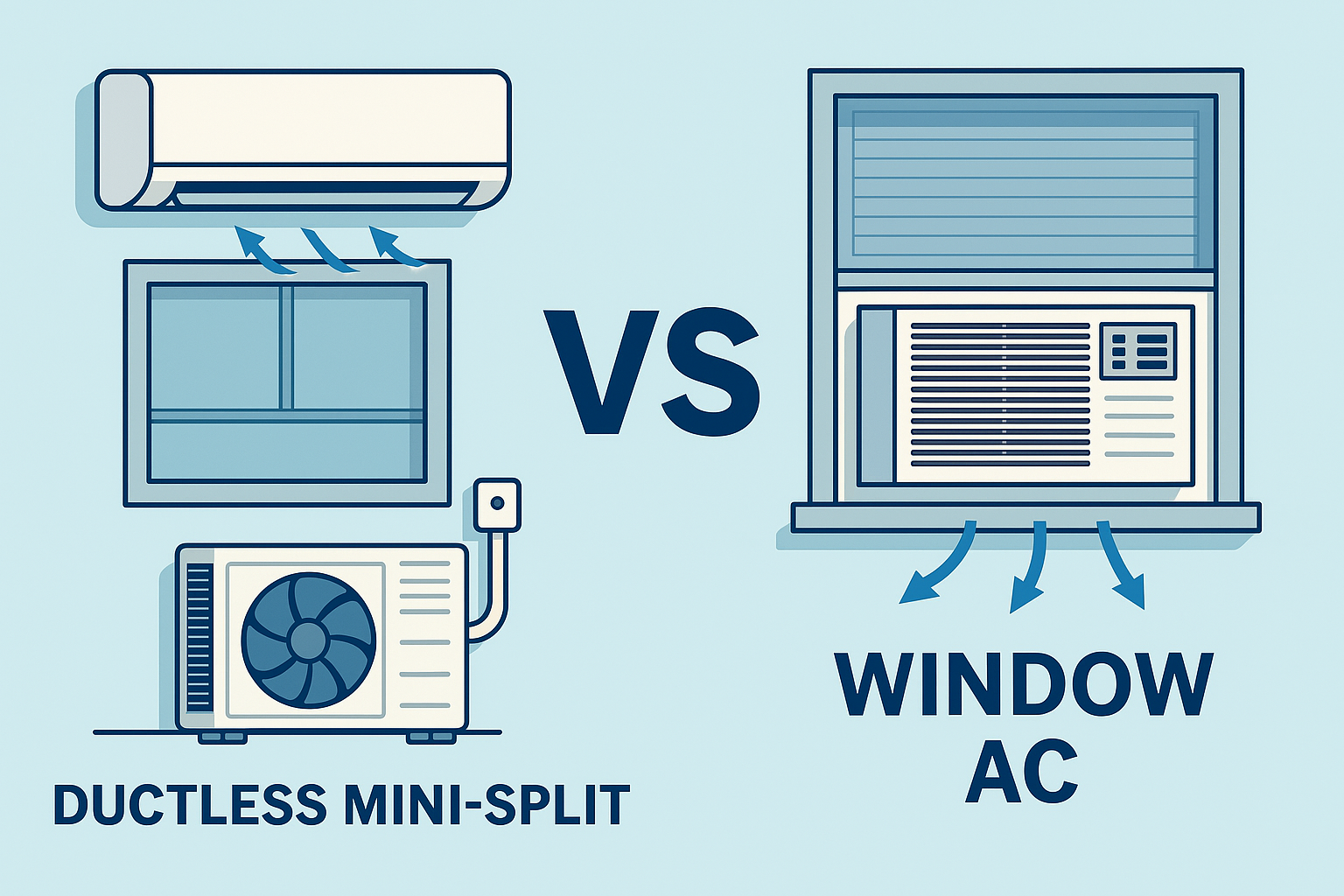Choosing between a ductless mini-split AC unit vs. window AC unit can be tricky, especially when considering cost, energy efficiency, space size, and installation. In this guide, we’ll help you compare both systems and determine which air conditioner best suits your home.
🪟 What Is a Window Air Conditioner?
A window AC unit is a compact cooling system designed to fit into a standard window frame. It cools individual rooms or small spaces and is ideal for short-term or temporary installation. Window ACs use refrigerants to chill the air and circulate it into the room using a built-in fan.
These units are:
- Affordable and portable
- Easy to install and remove
- Suitable for renters or small homes
However, cooling multiple rooms requires installing several units, increasing your overall energy usage and cost.
🌬️ What Is a Ductless Mini-Split AC Unit?
A ductless mini-split air conditioner is a permanent, high-efficiency cooling system that consists of an outdoor condenser and one or more indoor air handlers. These systems are ideal for both single-room and multi-zone cooling and offer flexible installation options — on walls, ceilings, or floors.
Key advantages:
- Customizable zone control (1–9 zones)
- Higher energy efficiency
- Long lifespan (15–20 years)
- Sleek and quiet operation
While more expensive upfront, ductless mini-splits offer superior long-term value.
💰 Comparing Costs – Mini-Split Systems vs. Window AC Units
Ductless Mini-Split System Costs
- Price range: $3,000–$6,000 (including installation)
- Requires professional setup
- Higher initial investment but reduced operating costs over time
- Lasts up to 20 years
Window AC Unit Costs
- Price range: $200–$1,000
- DIY installation possible
- Shorter lifespan (8–10 years)
- May need multiple units for whole-home cooling
If you’re on a budget, window ACs are a great short-term solution. For long-term savings and better performance, ductless systems are the way to go.
🌿 Energy Efficiency – Window AC vs. Ductless Mini-Split Systems
Both systems use electricity and refrigerant, but ductless mini-split systems are significantly more efficient and eco-friendly.
Mini-Split Energy Efficiency
- Uses 40% less energy than window units
- Operates with more environmentally friendly refrigerants
- Reduces electricity bills with zone-based cooling
Window AC Efficiency
- Efficiency depends on the model and its Energy Star rating
- Higher efficiency = higher price
- Often less effective in larger or poorly insulated spaces
Whichever you choose, ensure proper sizing and insulation to avoid energy waste.
📏 Sizing and Installation Considerations
Mini-Split System
- Requires correct BTUh (British Thermal Units per hour) based on room size
- Professional evaluation recommended
- Flexible mounting options (wall, ceiling, floor)
- Easily expandable for additional rooms
Window AC Unit
- Size based on square footage, number of windows/doors, and ceiling height
- Too small = overworked and inefficient
- Too large = poor humidity control
- Always check manufacturer sizing guidelines
Correct sizing ensures comfort and energy efficiency no matter which unit you install.
✅ Pros and Cons at a Glance
| Feature | Window AC Unit | Ductless Mini-Split |
|---|---|---|
| Cost | $200–$1,000 | $3,000–$6,000 |
| Installation | DIY | Professional required |
| Energy Efficiency | Moderate to Low | High |
| Best For | Small rooms, temporary setups | Multi-room or long-term cooling |
| Lifespan | 8–10 years | 15–20 years |
| Eco-Friendliness | Lower | Higher |
| Noise Levels | Noisy | Quiet |
📘 Final Thoughts: Which AC Unit Should You Choose?
Choosing between a ductless mini-split AC unit vs. window AC unit depends on your cooling needs, space size, budget, and long-term goals. For small apartments or temporary needs, a window unit is budget-friendly and easy to manage. If you’re looking for efficient, long-lasting cooling for multiple rooms, a ductless mini-split is the smarter investment.
